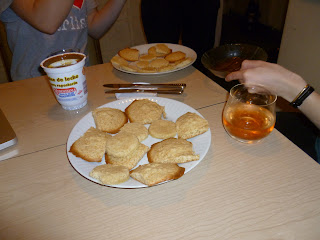In Argentina, the shop owners either don’t have change, or try at all costs to not to use theirs up. An exaggeration, of course, but it’s not that uncommon for people to say they can’t break 2 pesos (50 cents, American). Thus was my case. The man demanded exact change, down to the cents. I had to hunt through my money purse for coins, as people continued to slide their dishes on the counter next to mine and buy food. As I routed around for the last 10 cents, having already handed over the rest of the cash, I felt a brush of air, which I assumed was just another person taking their food. When I looked up, several moments later, my lunch was gone.
At first, I was merely confused, thinking that the cashier had been guarding my food until I paid him for it. He announced he didn’t have it, and rapidly lost interest, as I had already paid. The other cashier asked what was wrong.
I told them, “I paid but I don’t know where my lunch is.” The other guy kind of nodded and decided it wasn’t his business.
But I continued bothering the first guy, “I gave you money, and now I don’t have anything.”
I wasn’t quite sure who had been robbed as the food was stolen while I was still paying. Both of us, I guess. (An odd note about this, was that the person could have easily filled a dish and walked out the door, they didn’t need to wait in line to steal anything).
“You should protect your stuff,” the cashier told me, and went on to ignore me and check out other customers. I was rather annoyed. Being an American, I was raised to think that if the customers not always right, they at least deserve some respect. I was annoyed at him for insisting he wouldn’t accept my money unless I could find exact coinage and at him for not paying attention while I was distracted by paying him in the manner he insisted. In the U.S., the restaurant staff would have been apologetic over this situation, they would have offered me a new lunch, or a discount, I assume, but mostly, in the U.S. this wouldn’t have happened. I was annoyed at the cashiers for being part of a country where people didn’t even have the respect to wait until after I’d paid to rob me (and be clear that it was me he/she was robbing). Argentina is a country where strangers will stop to offer you directions without even being asked. It’s also a country where people will seize any opportunity. In the end, I announced to the cashiers that I had paid them for food, and so was going to take food, and I went and got a new plate, and left. Maybe I was a thief now, too?
History note, courtesy of my Service Learning class: since the latest financial crisis, Argentina has become known for petty theft. Violence is rare, but stealing is high. There’s not a lot of job stability, and so the poorer classes tend to move from one type of temporary work to another, and mix in petty crime. Jobs aren’t vocations or identities: no one has a job long enough to associate with it. Instead, it’s just another way of getting money, not different from crime other than having fixed hours. It’s common for people to hold a salaried job to pay for general expenses, and a side “job” of theft, to pay for fun.
That’s not to say everyone does this, but it’s been a noted trend, say the sociologists. I saw a documentary on a group of people called “carteneros” (there’s no exact translation, the best I’d say is “cardboard people”). These incredibly poor people work searching through trash for recyclables, which they can then sell to factories. It’s an awful job, paying only $1-2 a day, but it’s work, and it’s honest. One man said that people on the street derided him as a “tramp” for doing this work, but that he was proud of it: being a cartenero meant he was supporting his family in a legal way. He was proud when kids in his shantytown stopped being thieves and became carteneros.
It’s a weird hypocrisy, but I think society respects thieves more. Because being a thief means that you have more control and dignity. As a thief you don’t work for the man, you make your own rules. You’re proactive. Sure you’re harming someone, but the very fact that you’re harming someone means that you have the ability to harm someone, you has effect. But a cartonero? You’re digging through other people’s trash, and just to scrape by; everyone realizes you’re not paid anything close to how much time you put in, and it’s not just a dirty job, you’re spending all your time searching through the stuff that society has specifically deemed “untouchable”. Sometimes, it seems people would admire you more if you robbed them than if you respected them.







